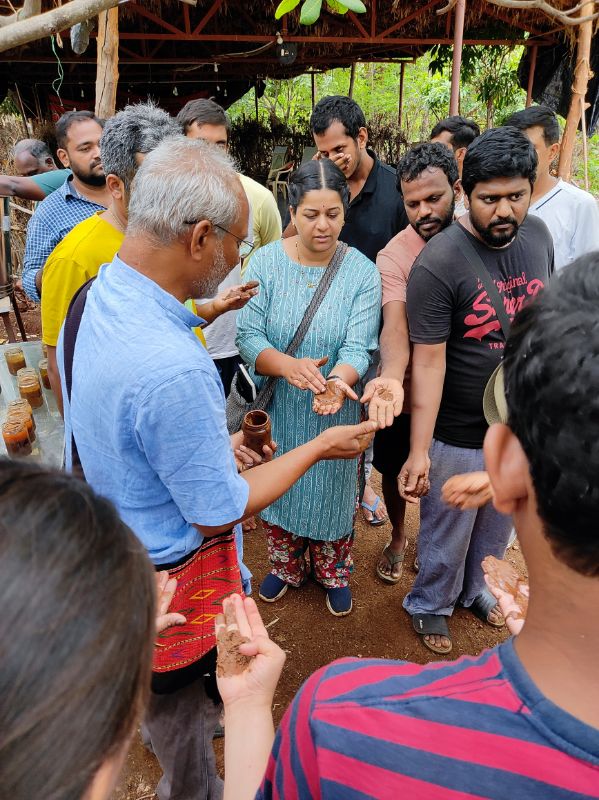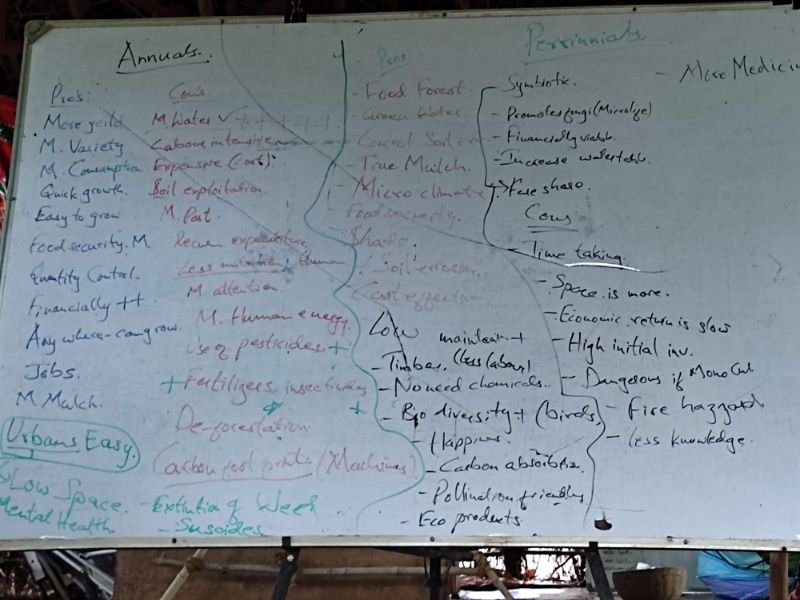PDC 1: Tactile Ideas
This first set of stories is about the discovery of new ideas that shaped me fundamentally. And the best part is that there was always a tangible way to learn about and explore all of them!
Earth Care, People Care, Fair Share
I’d often heard people say ‘Permaculture is a way of life, not a method of farming.’ This idea came to light beautifully as we spent the first day discussing the 3 ethics and 12 principles of permaculture. The three ethics of permaculture are ‘Earth Care, People Care, and Fair Share.’ The image on the left is the mind map I created that day. I believe these three guiding ethics create an extremely powerful framework that can be used to assess the resilience of anything, However, it can still be daunting to keep all three ethics in mind when we take them beyond a piece of land. In our discussion, I found a starting place: to think of Fair Share at the individual level, People Care at the community level, and Earth Care for all beings. This ideal lives and breathes at Aranya, where there is Fair Share among all creatures, tremendous engagement with and care for the community, and a commitment to looking after the earth.
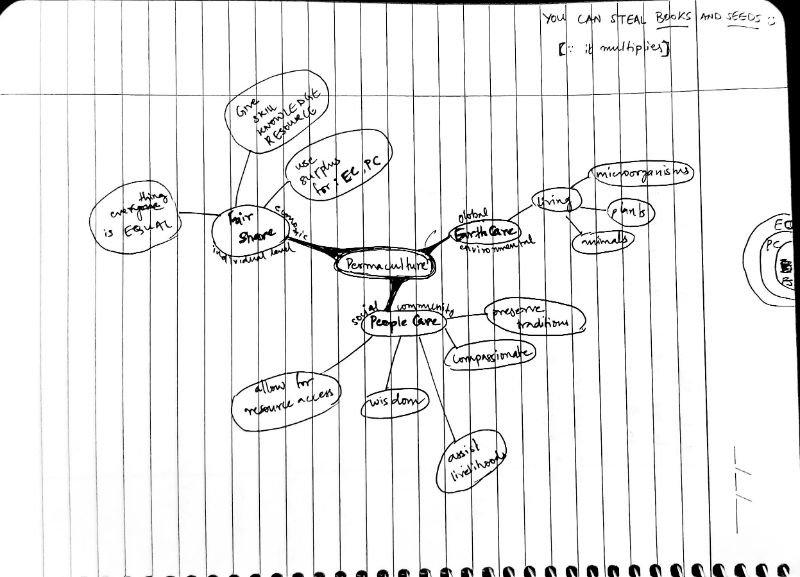
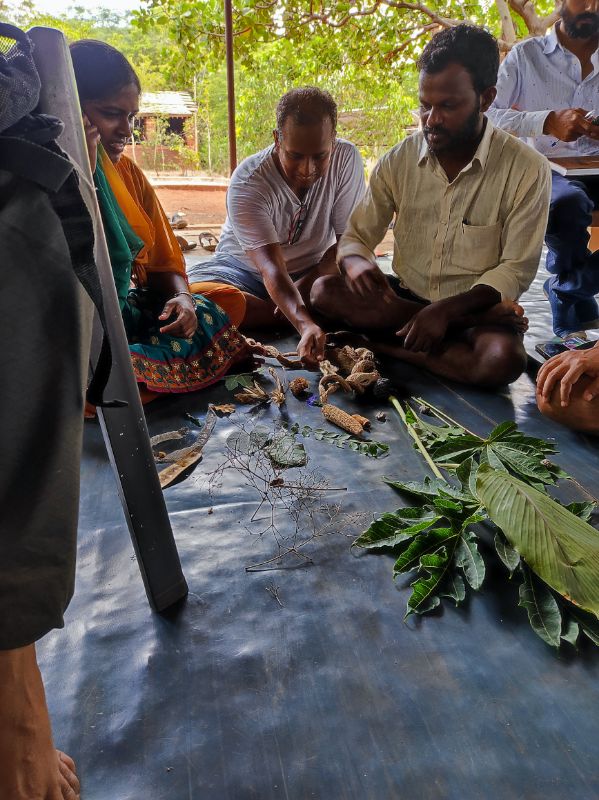
Patterns in Nature
I’d gone hunting for patterns in nature several times before. For example, finding the Fibonacci spirals in flower centres or measuring angles between leaf arrangements using the golden angle-a-trons I’d discovered from Vihart’s math videos. I knew I was barely scratching at the surface, so it was exciting when we went on a pattern hunt during the PDC. However, this time we had to think carefully about how the ‘form follows function’ in the patterns we had found.
Nature does not have a conscious will to decide its patterns and often the true reasons for its patterns lay hidden behind complex biochemistry. However, we took our shot at guessing the outcomes of those ancient evolutionary processes: maximising exposure to sunlight, efficient seed dispersal, attracting pollinators etc. Initially, it felt unsatisfactory to stop there and not look for deeper reasons, but I soon realised that those outcomes were what we could learn from. For instance, we could learn how to optimise space or slow and collect water.
Testing Soil
Sampling and testing soil is a common way to work with it and is undeniably useful for learning about soil. However, at the PDC, I experienced a different approach. Instead of trying to find out the exact percentages of NPK or organic matter present, we used simpler but insightful techniques. Throughout the whole process, I felt like a child: mixing water and soil in a glass jar to see how it would settle, making soil balls and seeing how well they rounded up, and observing the number of washes it took to completely wash the soil from my hand, among other things. The process brought all my attention to my touch and vision, and I rediscovered how gravitational separation was such a powerful technique. The sand, silt, and clay had separated into distinctive layers over a 24-hour period, exposing the makeup of the soil.
But beyond reconnecting me to my ability to understand the soil, these techniques are so powerful because anyone can do them. This would enable people even in the most remote locations, letting them understand and take care of their soil better.
(The image shows Narsanna using all the soil samples to demonstrate the types of soils on the farm and doing a ‘sticky test’ with soil balls to see how well they stuck to a cardboard board.)

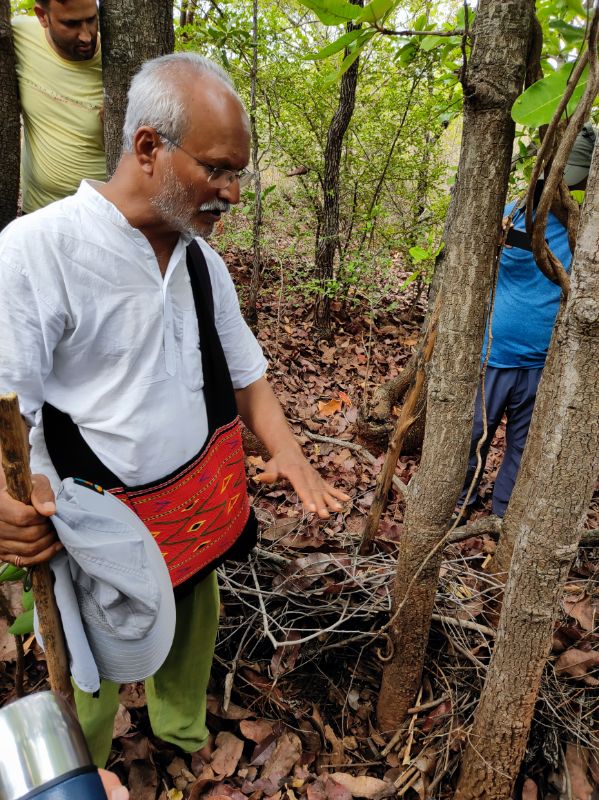
The Magic of Bunding
The landscape around Aranya farm in Zahirabad, Telangana is vastly different from the thriving oasis found within its boundaries. The semi-arid region receives an annual rainfall of around 600mm and has seen thousands of acres of natural forest cleared and replaced by invasive eucalyptus trees. These invasive trees have only hurt the environment further as they are allelopathic and restrict the growth of other species, their leaves do not biodegrade, and their deep roots consume excessive amounts of water. In the absence of vegetation, the surrounding hilly terrain has also become barren due to erosion.
However, amidst this desolation, there is a small beacon of hope. Narsanna sir placed rock bunds in the path of some of the gullies on a hill nearby, slowing down the flow of water. Over time, this has resulted in a densely vegetated patch of trees. The gully, which was previously an area of erosion, is now a thriving ecosystem. Along with the dense root system that has developed over the years, punctuating the gully with brushwood bunds (shown in the picture) also helped to slow down the water flow and create a rich soil environment. The simple intervention has been so successful that the temperature of the air changes on stepping into the gully, and the hot air outside blows like a cool breeze through this area. The air carries the petrichor coming from the decomposing leaves and rich soil, creating a pleasant microclimate.
This simple yet effective solution shows how even a small change can have a positive impact on the environment. I guess not all complex problems require complex solutions.
Watering Cans and Tiny Hills
Aranya Farm was a dry and desolate landscape when it was first acquired. Now, it is a lush and vibrant permaculture farm. One could say that the primary reason for this transformation is the elaborate water harvesting system that has been dug into the landscape. The stone bund above was one example of a water-harvesting structure. However, the kind of structures one can use is only limited by one’s imagination— from shallow swales to large farm ponds.
The eye-opening thing about the water harvesting session was how logical the entire process is. With the simple principle of ‘slow, spread, and sink’ one can design effective water-harvesting systems. And yet, it isn’t an inherent part of the way we build, leading to routine monsoon floods in Indian cities.
To explore how well we’d understood the concept, we made our own water harvesting structures on model mud landscapes. Then, we tested their effectiveness by making it “rain” with a water can.
(The image shows Adi correcting and improving the structures made for the challenging hilly terrain after the rain test.)

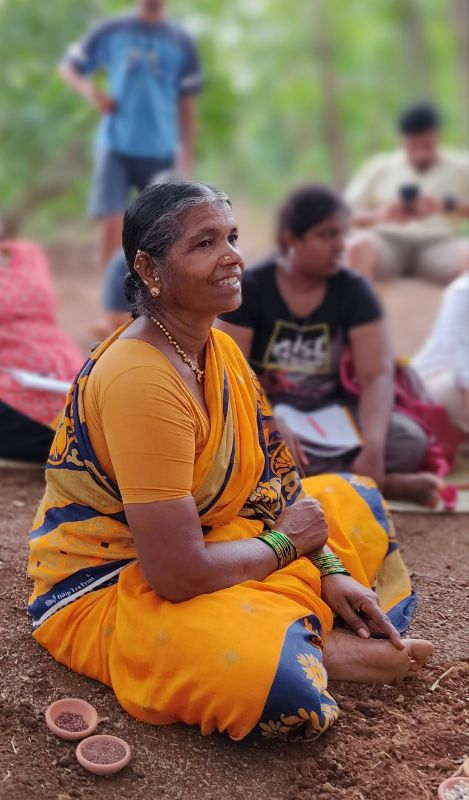
Samamma
Samamma is a permaculturist, village elder, and international speaker. She visited Aranya to talk to us about mixed cropping. The ingenious way in which her field is panted, there are things to harvest at almost all times of the year. One field hosts nearly twenty varieties of crops. If one fails, she has the other nineteen to support her. It is a truly resilient system! Further, by planting crops in different rows each year, and leaving a few months for green manure, her soil is rich and well looked after.
Beyond cropping patterns, she is acutely aware of the generational patterns in her village. Though she is immensely proud of her farm and its ability to look after her family and the earth, she is upset by the younger generation and their desire to leave the village and take up jobs in the city. I observe a strange cycle. I do not have statistics, but there seems to be a movement among some of the most well-off people to return to simpler and rural ways of living. At the same time, those in the villages dream of jobs in the city. Unfortunately, the wisdom from either of their experiences can not be shared, only lived.
Regardless, Samamma is a stronghold within the village community, and an inspiration for both the youth in her village and us, the mostly urban participants of the PDC.
Redefining Food
Alongside this session with Samamma, we had the village’s natural healer, Pushpalamma, also visit us. Here’s the beautiful part: every single plant that she taught us about was simply collected from the farm. This is so starkly different from the predominant monoculture farms. Further, most of these plants were not manually introduced or looked after, they were growing independently as uncultivated greens. Pushpalamma taught us ways to help with a range of diseases, from jaundice to mouth ulcers.
As we explored these uncultivated greens, I realised that many of them are also edible and part of my diet. This idea resurfaced strongly when we discussed annual and perennial crops and their contributions to food security. Though most of the world is dependent on annual crops for its food, perennial and uncultivated crops have the potential to play a more significant role. However, some perennial and hardy plants, like chaya (Cnidoscolus aconitifolius), are scarcely known. I wish some of my rote learning in school had gone into learning about these plants—plants that can feed and heal me—instead of memorising organic chemistry reactions that I will never use.
These sessions led me to a big question: how can we try to solve or assess the problem of food security if we don’t even know everything that can be food?

Some more glimpses from the PDC



